DriveThru RPG: https://www.drivethrurpg.com/en/product/485388/Daimyo-of-Storkway
Itch.io: https://rainer-kaasik-aaslav.itch.io/daimyo-of-storkway

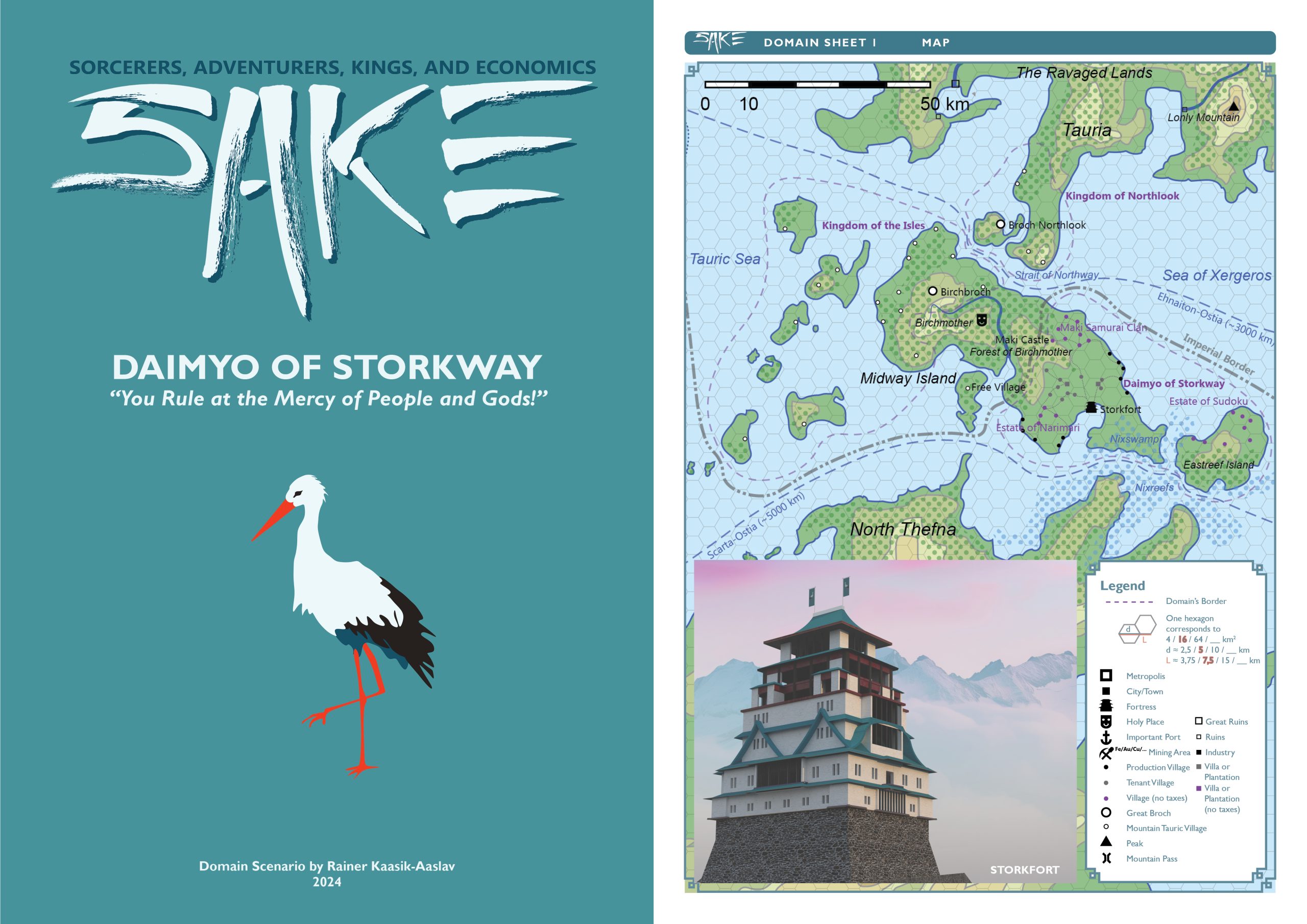
DriveThru RPG: https://www.drivethrurpg.com/en/product/485388/Daimyo-of-Storkway
Itch.io: https://rainer-kaasik-aaslav.itch.io/daimyo-of-storkway
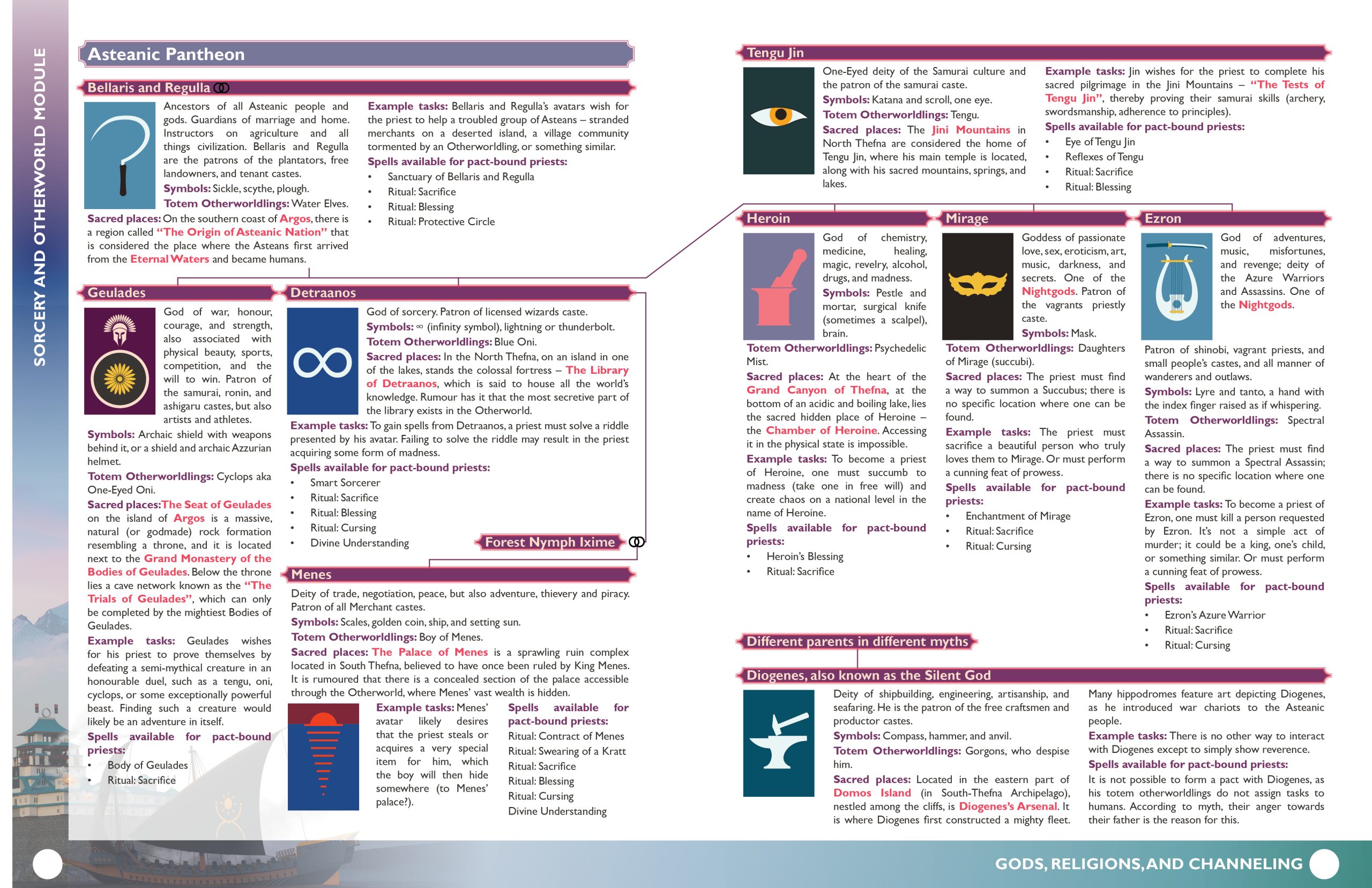
In the Asteanic World, there are many gods and various religions.
Gods are divided into two types: major deities and lesser deities.
Major deities are associated with larger, overarching concepts, such as the god of death, the god of trade, the god of the sea, or the god of war. Lesser deities, on the other hand, are either nature gods linked to specific locations, like the god of that lake, forest or swamp, or ancestor-gods associated with specific human groups, such as our tribe’s ancestor god or the ancient god-king of this city, and so on.
Major deities are characterized by their elusive nature to humans. There is no specific place where they reside, no clear understanding of their appearance, and no direct way to communicate with them. Therefore, their nature is largely the domain of theological debates.


Blogpost about The Doctrine of Eternal Waters, also known as the Temple of the Divine Ocean or just Asteanic Polytheism: https://sake.ee/religions-in-the-asteanic-world/
One can make pacts with as many major deities as they wish, as pacts with major deities do not come with any taboos that need to be written on the Character Sheet. To make a pact, one must summon the major deity’s totemic being or visit a sacred place where a major deity’s totemic being resides. The totemic being assigns a task to the priest. These tasks are complex, and completing one task can be a whole adventure.
Lesser deities are actual beings in the game to whom the Game Master can assign Health Points, Skills, and Abilities.
All lesser deities belong to a certain deity class or portfolio, which determines the spells that can be acquired by a priest who enters into a pact with them. The classes of lesser deities are wind deities, water deities, forest and earth deities, mountain deities and ancestors.
Establishing a pact with lesser deities necessitates initial contact with them, which can be achieved through a Theology Ritual: Prayer (only effective when the character is in the same region as the deity) or physically seeking out the deity.
To formalize a pact, a priest must fulfil the task assigned by the lesser deity and adhere to the lesser deity’s taboo or principle which has to be written on the Character Sheet. Tasks set by lesser deities are typically less complex than those imposed by major deities.
Priests have the capacity to enter into pacts with up to ten lesser deities, as each new contract requires the adoption of one of the deity’s principles or taboos, and characters can possess a maximum of ten principles and other personality traits.
To use priest spells, a PC must purchase the skill: Channelling, which is not initially present on the Character Sheet. Channelling is an Instinct skill.
However, characters can forge contracts with gods without possessing this skill. For instance, if they plan to become a priest later or wish to earn favour with a local nature deity through a contract.
There are two ways to acquire the Channelling skill:
Technically, Channelling works the same way as other magic: the priest selects a spell to cast, makes a Channelling check as indicated in the spell description, and the spell consumes Spellpoints.
Priest spells are categorized into three groups, all utilizing the Channelling skill:
The first group consists of Self-Powered spells. These abilities are not specifically linked to any particular deity, meaning they can be acquired even without forming a pact with a god. Characters can attribute increased strength or a more potent strike to a deity, but in reality, it’s their own faith and soul’s energy at work. These spells only affect the priest and do not influence anyone else without additional abilities.

The second group of spells originates from contracts with lesser deities. These spells can influence the external world more realistically than other magic. These contracts are tied to a lesser deity, and the priest channels the world-altering energy of that deity. A priest can form contracts with up to ten lesser deities, but in return, they must perform deeds for the deities and embrace the taboos or principles of those deities. Breaking a lesser deity’s taboo may result in the contract breaking (50% chance). Additionally, it is possible to kill lesser deities, in which case priests lose their spells.

The third group of spells comes from contracts with major deities, which can be made by receiving tasks from and fulfilling them for the major deity’s totemic creature. Spells received from major deities are powerful, and acquiring them requires significant effort to please the deity. Once a contract with a major deity is established, it never breaks.

Additionally, there are theology rituals that do not require the Channelling skill at all.
SAKE Full Book at Kickstarter: LINK

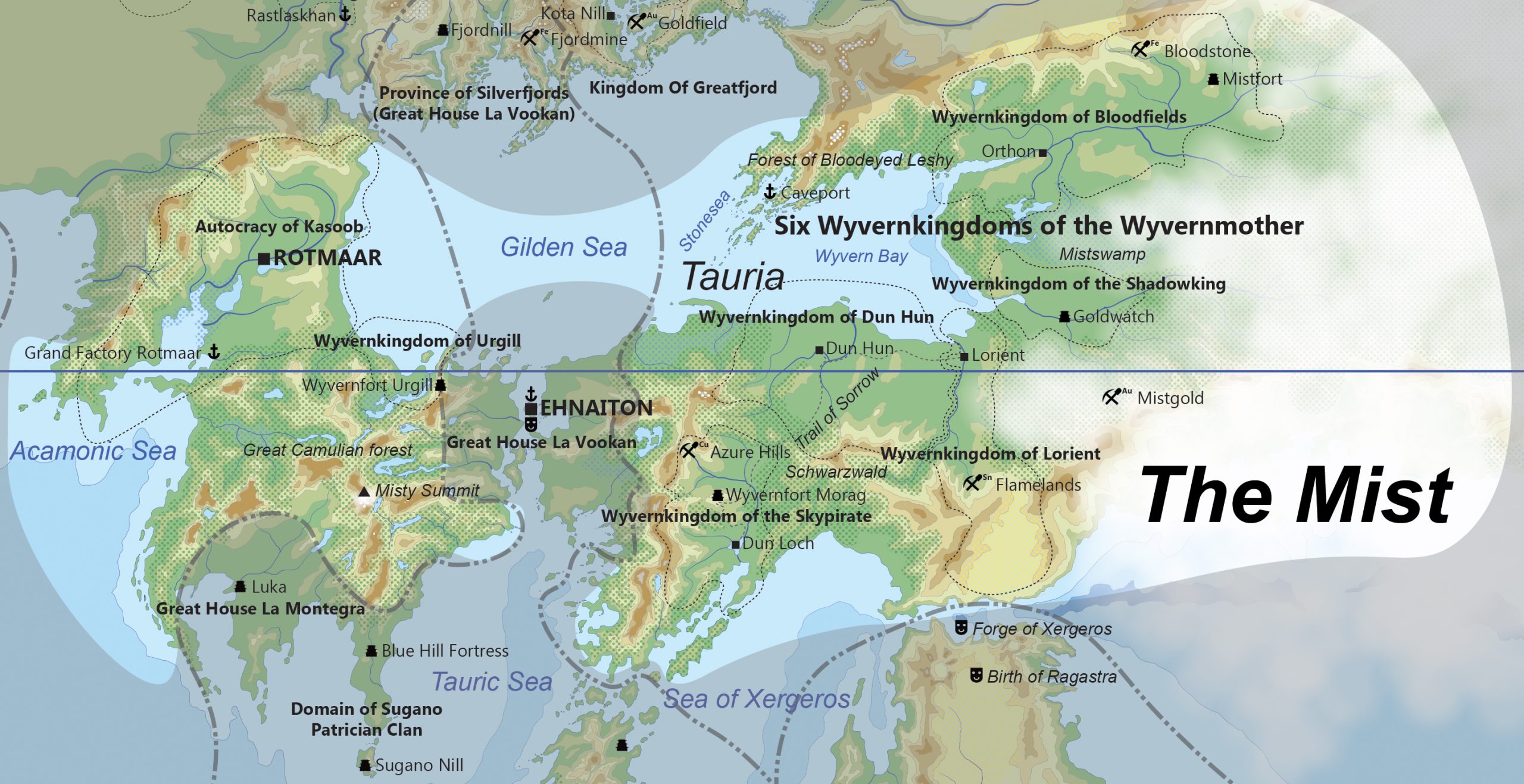
This post is an example of how Trade Regions are depicted in the SAKE Full Book.
Each of the 12 Trade Regions covered in the book will have similar pages, including:

The Tauric people inhabit the shores of the Gilden Sea, comprising two distinct groups: the mountain tauri and the plains tauri. Mountain tauri, untouched by the Asteanic Empire, reside in mountain forests practising permaculture and hunting. In contrast, plains tauri were under Asteanic rule for centuries until recently gaining freedom with the use of a natural air force – Wyvernknights. They have adopted the Asteanic alphabet for their written language.
Taurics are renowned for their martial prowess, excellent metalworking, bravery, and melancholy captured in epic poems by their bards. Tauric people lacked the strict social hierarchy present in Asteanic society. All Taurics had the right to bear arms, own land, and move freely. However, this is changing in the Wyvernkingdoms, as these crucial military animals, an assurance against a more powerful Asteanic Empire, require an ungodly amount of food.
Asteans and Tauri share parts of their polytheistic religion, albeit with some differences in understanding their pantheons. The Taurics hold a great fear of the world’s end, prophesied to come from the east in the form of a massive fog inhabited by terrifying creatures, including Mist Dragons. This ominous fog is foreseen to consume Tauria and the entire world, signifying humanity’s end.
In the present day, mountain Tauri are organized into small mountain kingdoms, with numerous mountain kings due to their size. Many Taurics still live under the La Mepho-Delagrua’n Asteanic Empire, while those freed by the Wyvernmother reside in one of the six kingdoms ruled by her sons.
(From oldest to youngest)

Curstag the Shadowking is in his late seventies. Surrounded closely by the Mist, swamps, and forests, Curstag’s kingdom is the oldest Wyvernkingdom, its independence from the Asteanic Empire dating back to the time before Wyvernmother. When the once significant region of the empire’s gold mines, Mistgold, fell into the Mist over a hundred years ago, the local Taurics fought for their independence without much resistance from the Asteans.
Wyvernmother initiated her campaign against the Asteans right here in this kingdom, venturing into the Mist to the Mistgold region, from where she brought out great wealth to finance her first military campaign. Inspired by this, adventurers still venture into the Mist to reach the Mistgold gold mining area and bring out treasures – but few of these adventures succeed.
The Kingdom of the Shadowking has only 15 000 inhabitants and no real towns or cities – the king and only one company of Wyvernknights reside at the ruined old Asteanic river fortress Goldwatch.
The second son, Dormac the Soulsmith, also known as “The Smith of Gods,” rules as the Wyvernking of Lorient. The king is renowned throughout the Tauric lands and beyond for his exceptional soulsmithing abilities. Dormac is so revered that when people wish to offer an exceptional gift to a god, they commission a magic item from him.
The Kingdom of Lorient, with a population of 100 000 and covering an area of 40 000 km2, is centred around the old Asteanic city of Lorient, which has a population of 12 000. The kingdom’s primary exports are tin, metalworks, and other Tauric trade goods. In recent years, relations with the Asteans have been peaceful, leading to flourishing trade.
In the south, the kingdom encompasses an empty desert plateau, particularly favoured by dangerous phoenix birds whose ashes are used to make a special makeup highly prized by the Asteanic nobility. Young Wyvernknights and other adventurers venture into this area to hunt these massive otherworldly birds made of fire – an extremely perilous undertaking.

Railbert the Bloodeye, who is in his early sixties, arguably holds the greatest of the Wyvernkingdoms – the Wyvernkingdom of Bloodfields. Railbert’s kingdom is the largest (approximately 100 000 km2) and most populous (with around 300 000 people, 15 000 of whom live in the city of Orthon). The Wyvernkingdom of Bloodfields has a fully developed feudal system with Wyvernknights at the top, Landsknights second, and commoners and serfs after them – quite similar to the Asteanic system, just a bit simpler (and replace samurais with Landsknights). Also, the Wyvernkingdom of Bloodfields has somewhat normalized relations with the Asteans, with many Asteanic merchants living in Orthon (which is an old Asteanic city). Bloodfields exports a considerable amount of iron, all sorts of steel products, and other Tauric region trade goods to the Asteanic World trade system.
The city of Orthon is a self-governing city governed by local trade and craft syndicates and representatives of the king.
Railbert holds his court at Mistfort – a huge mountain fortress built to house 200 wyverns, Wyvernknights, their families, servants and all sorts of officials. Railbert is known to be the only king who takes the threat of the Mist more scientifically and is actively trying to find a solution to the encroaching Mist. He regularly sends adventure parties into the Mist and has hired a great number of mages and metaphysicists from all over the world to find a way to stop it.
For reasons unknown to the public, the local nature god – The Bloodeyed Leshy – hates the king and his dynasty and has cursed him and his children with blindness and blood running from their eyes.

Wyvernking Wynter the Singer rules over the small Wyvernkingdom of Urgill, with a populace of only 25 000 and just three companies of Wyvernknights protecting it. Wynter conquered his kingdom from some Asteanic landowners around 40 years ago with a small band of Wyvernknights. The kingdom is situated on the western coast of the Gilden Sea and is far away from the lands of his brothers.
Currently, Winter enjoys somewhat normal relations with nearby Asteans and rarely takes part in his mother’s military campaigns. Wynter resides at Wyvernfort Urgill, loosely governing the local lands. His wyverns pose a significant challenge for the local populace, who must make their living farming the poor, swampy soils of the area. The king and his knights are hated and feared, but they themselves are not malicious – the wyverns simply have voracious appetites for meat.
As the king is somewhat impoverished and faces no imminent threats to his power, it may be possible to convince him to hire out his Wyvernknights as mercenaries or even to conquer his kingdom from him.

Wyvernking Urrigan the Warrior rules over the Wyvernkingdom of Dun Hun, which has been at the forefront of the war against the Asteanic Empire for decades. The kingdom has endured cycles of destruction and reconstruction, leaving it now dotted with duns – circular fortified hilltowns.
The plains Tauri of Dun Hun have adopted a warrior culture akin to that of mountain Tauri. In Dun Hun, everyone is free and expected to take up arms when the king goes to war. Despite its population of 240 000 and a land area of 60 000 km2, the kingdom can muster an army of almost 20 000 warriors – a considerable force relative to its population.
How is this possible? Firstly, Dun Hun receives substantial subsidies in the form of food and arms from other Wyvernkingdoms. The kingdom has been the primary battleground in the fight for independence for decades, and supporting Dun Hun has helped to maintain the integrity of other kingdoms.
However, there is also a darker aspect to this situation. Many farms in the kingdom are operated by slaves, with Dun Hun being the main customer for Morag the Skypirate and the pirates of Caveport in the slave trade. They even purchase slaves from Rastlaskhan in the Zuharic lands. The slave raids around the Gilden Sea are solely attributable to the Wyvernkingdom of Dun Hun. Warriors from Dun Hun frequently conduct raids into Asteanic territories and even Tauric mountain kingdoms to procure slaves.
Wyvernking Morag the Skypirate rules over a Wyvernkingdom despised by all Asteanic and Tauric merchants, as well as by his own people. There isn’t much one can do when wyvernpirates descend from the sky to your ship, plunder everything, and sell you into slavery – and Morag doesn’t discriminate – the days of freedom fights against the Asteans are over for him, now everybody is fair game.
Skypirate isn’t a good king, as he treats his subjects just as poorly as his victims. Although the region he rules over is large (approximately 30 000 km2) and historically populous (though today only about 90 000 inhabitants), in reality, he resides with 200 wyverns, 100 wyvernpirates and their families, and numerous other lackeys in isolation within his impregnable Wyvernfort, which is brimming with plundered wealth. His wyverns roam freely over his lands, raiding the herds of local farmers or even killing them outright – such a horde of wyverns requires a vast amount of meat every day. Life in the Wyvernkingdom of Skypirate is like hell on earth, but at least nobody collects taxes.
With the copper mining area of Azure Hills abandoned, the city of Dun Loch (with 10 000 inhabitants) constantly fighting for survival, and the kingdom essentially rulerless, this area could be a good place for adventurous types to start their own kingdom – if only they could eliminate the pirate king. Of course, if successful, revenge or some backlash from his brothers is to be expected.
The youngest son Wyvernprince Fergus the Thundersinger is in his fifties and doesn’t have a kingdom jet(!).
Wyvernmother herself visits each of her sons in turns, living with them as she travels in the form of a Gigantic Quasicorporeal Wyvern.
The Autocracy of Kasoob stands out in the Tauric region as a peculiar entity – it is primarily settled by the Acamonic people who migrated there hundreds, if not thousands, of years ago from their homeland across the Acamonic Sea.
Ruled by the priesthood of the Acamonic fertility deity, Kasoob, the state appears to thrive under its leadership. Despite the swampy terrain and poor soils, the Autocracy of Kasoob enjoys prosperity and a sizable population (400 000 inhabitants, with 75 000 of them residing in the city of Rotmaar). Essentially functioning as a large city-state, the hinterlands serve primarily to support the grand temple-city.
The Autocracy of Kasoob remains largely isolated from the outside world. Trade with them is monopolized by the Asteanic Great House La Severin, which controls The Grand Factory Rotmaar. Consequently, there is little room for other merchants, and it is known that the state is not particularly fond of tourist travellers.
Mist is a separate blogpost in this case: https://sake.ee/the-mist/
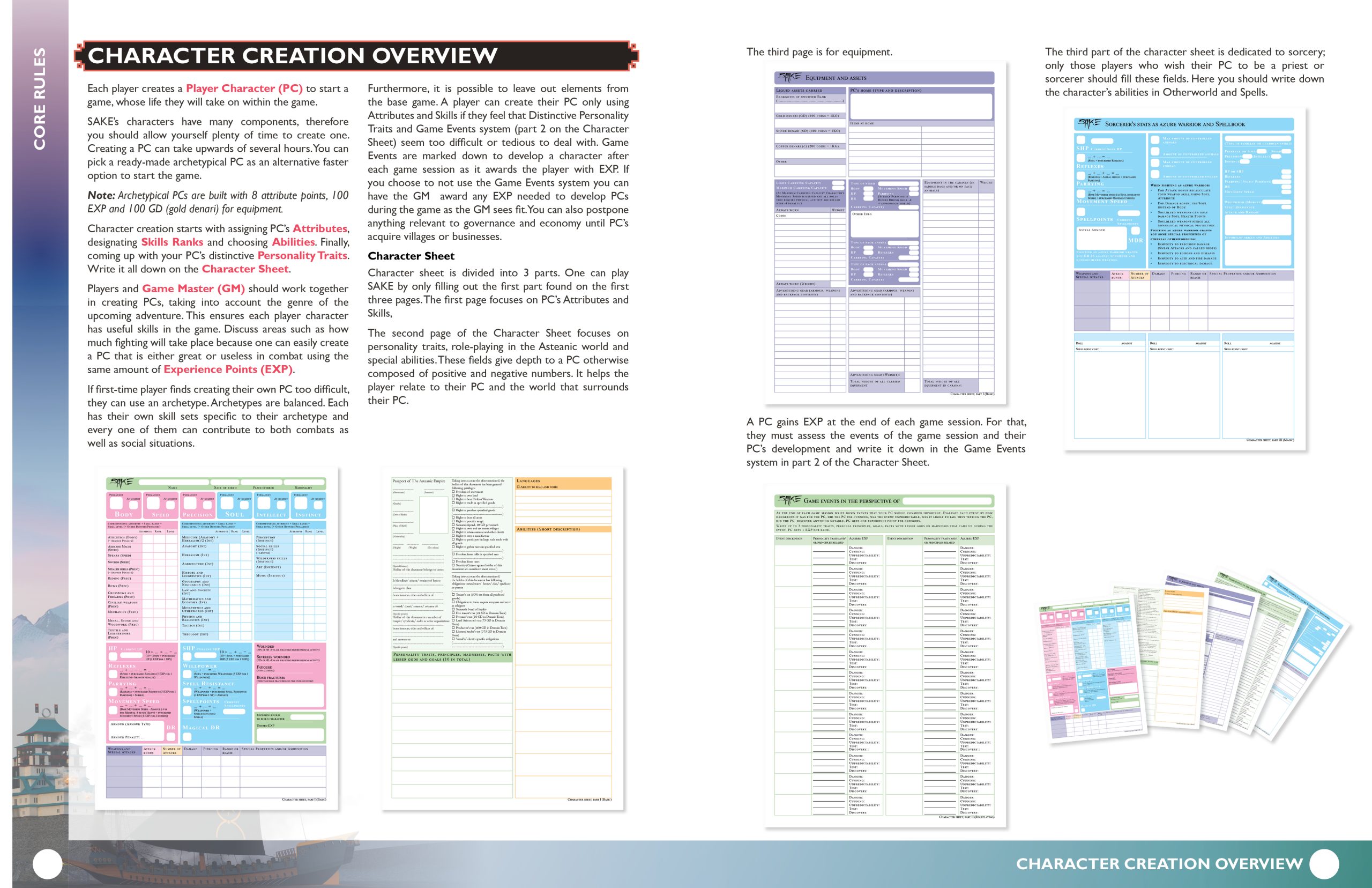

SAKE is a (levelless, classless) point-buy system, all Skill Ranks, Abilities, Spells, etc are bought with EXP. So where does the EXP come from, for that let’s go to character creation. When creating a character, the player chooses personality traits, principles and goals of the PC. Pacts with lesser gods and madnesses – we come back later.

At the end of each game session players journal every encounter/event/scene that was played through. Evaluate, whether was it dangerous for them, did they discovered something new, did it tested their skill and so on, getting 1 EXP from each tick. They also write down, did any of their personality traits came up in the scene, and did they move closer to achieving their goals (also 1 EXP).

This simple journal serves two purposes:

Coming back to Madnesses and Pacts with Lesser Gods. When a character wants to use spells powered by a lesser god, they must at first form a pact with the god. As part of the pact, they must embrace a taboo or conviction. Depending on god, it can be something simple like protecting forests from over-forestation or more complicated like never fleeing from battle.

At the same time, mages studying magic, have to deal with unseen forces of the Otherworld that can change their Soul and personality. Every time a character learns a new spell, there is a chance that they have to take a new madness. These madnesses, named after the gods of the Asteanic World are serious business for two reasons. First, they come with penalties, second, they start to clutter the personality traits section of the Character Sheet. So, the mage runs a risk of having to delete their personality traits to replace them with madnesses.

First, let’s look at a powerful divine ritual: Wind Control.

As we see for most powerful effects, the priest must roll against DL 80, which at first may seem just impossible.
Achieving such a high roll is only possible for a character whose Channelling Skill Level is at least +18, as this is a prerequisite for purchasing the ritual.
However, that’s just the beginning.
The Ritual Mastery Ability can add up to +26 to the roll, but this bonus comes with requirements:
Also, with a good Theology check, the same Ability can grant additionally up to a +12 bonus.
Next, Ritual: Sacrifice involving human sacrifice, with the highest successful roll, gives another bonus of +28 to the overall roll.
With all prerequisites met, the priest would roll Channelling with a bonus of +84, enough to summon the storm of ages. However, attaining this bonus requires fulfilling all prerequisites and achieving extremely successful rolls on the way. Also, it involves a voluntary human sacrifice – a scenario with many dependencies that may not always align.
Firstly, the significance of human sacrifices. In many fantasy settings, we often encounter cultists and evil cultures that engage in the practice of sacrificing people, but the rationale behind such actions is seldom explored. These numerical bonuses provide a tangible explanation for these unsavoury practices. Especially when rolling high numbers is rarely necessary, the scenario of human sacrifice emerges as a last resort in times of dire need – perhaps to sink an enemy’s navy or calm a storm that threatens to sink their ship – very real situations that may come up during Your game and place PCs to an interesting moral dilemma.
Moving on, describing rituals. Picture yourself as the GM narrating scenes where NPC priests engage in intricate dances, burn incense, and sing together as part of a spellcasting ritual. However, when it comes to PCs casting the same spell – they just cast it?
In the Asteanic World, the most significant temples are those inhabited by Otherworldlings. Despite their dangerous nature and alien way of thinking, these creatures are often housed in temples. This raises the question: why hold such entities in temples? Once again, the provision of real numerical bonuses for priests active in these temples provides justification for their presence.
This is just one example of how the rules in SAKE intertwine with worldbuilding. Other examples include:
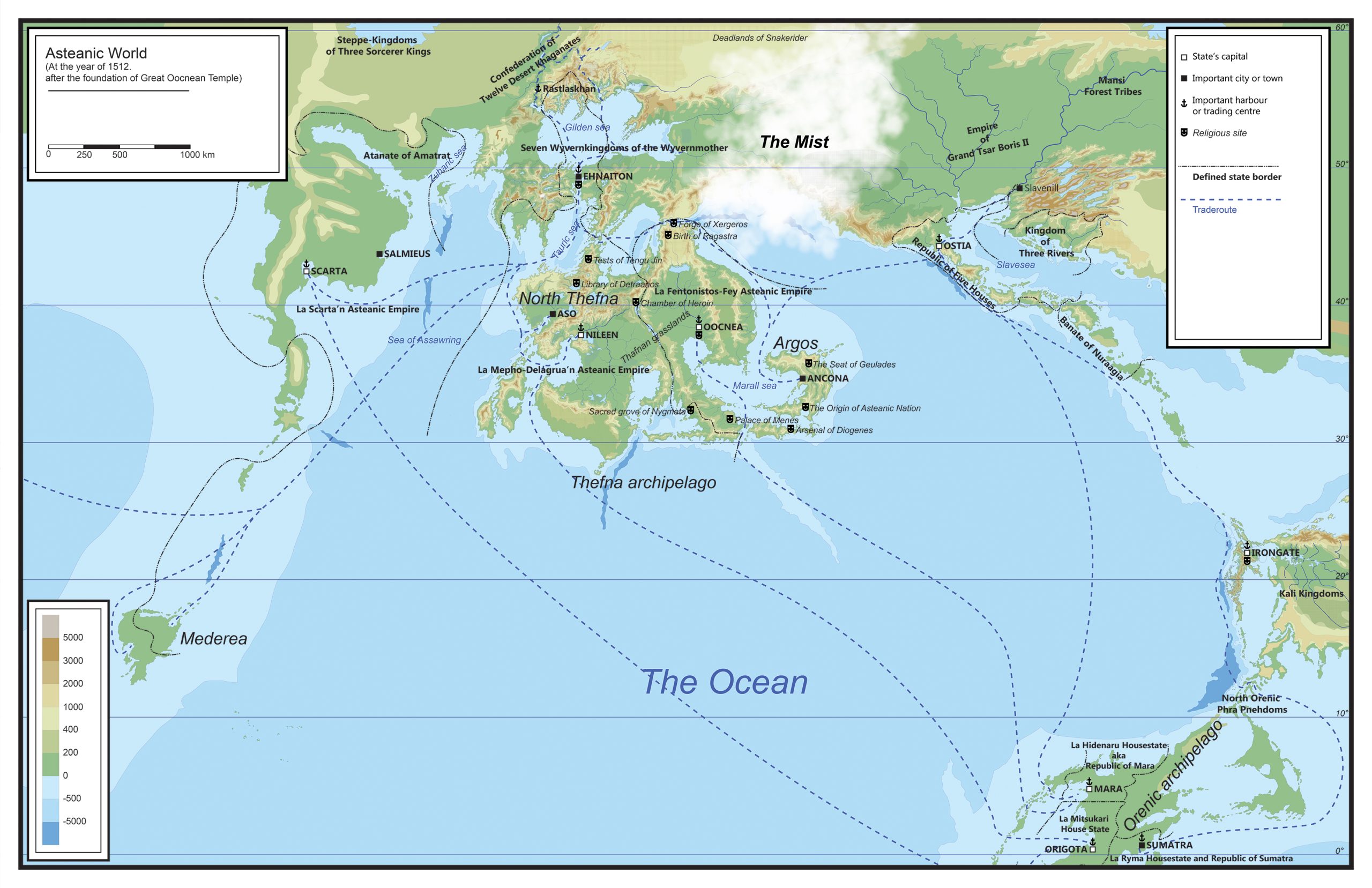
Asteanic chronology divides the world’s history into four eras: the Mythic Age when Thefna (the Asteanic motherland) was home to the lost Azzurian civilization, the Age of Heroes when gods walked the earth and ancient heroes cleansed the world of all kinds of monsters, making it habitable, the Age of Kings when the first Asteanic kingdoms rose, marking the beginning of credible written sources, and the Age of Empires or the New Age, that marks the start of the Asteanic calendar.
Little has survived from the Mythic Age, likely ending approximately 3000 to 4000 years ago. During this time, Thefna was home to the Azzurians, a completely extinct or assimilated people among the Asteans. The remnants of this era on Thefna include several ruined cities with massive necropolises and ziggurats. The largest among them are Urtari, Hatussa, and Mitanni, located away from the main civilization. Cities closer to civilization have largely been dismantled by the Asteans for their construction projects.
From the Azzurians, Asteans inherited something of immense significance: their gods. Asteans consider the Azzurian gods as deities of natural forces and continue to revere (mainly fear) them to this day. Azzurians identified themselves as the children of the sun god Azzur and worshipped and feared their gods fervently.
While some aspects of Azzurian writing have been deciphered, the absence of significant texts raises more questions than answers about their culture. Historians debate whether the Azzurians were aware of the Astral Projection magic school. What led to the demise of their culture and paved the way for the Asteans? Some signs suggest that the Azzurians harboured immense fear of otherworldly forces and death. Why, what was so different in that time?
The Age of Heroes marks the beginning of Asteanic mythology. The era commences with the tale of how the Asteans descended from the Eternal Waters (pocket of the Otherworld) to the human world. All stories of the deeds of Asteanic gods fall into this era.
The Age of Heroes also encompasses tales of various human heroes and the slaying of monsters and dangerous lesser gods.
There are no written sources from the Age of Heroes because the Asteans had not yet developed writing. All stories have been preserved as oral traditions and are therefore more myths than subjects for serious historical inquiry.
It is unclear whether the Azzurians lived alongside the Asteans during this time. Oral tradition is contradictory in this regard. In some tales, Asteanic heroes battle seemingly foreign nations, but these may also be kinfolk of the Asteans (Asteanic language only becomes standardized in the Age of Empires) or the Hattu peoples who lived in Northern Thefna. In other stories, the Asteans find Thefna seemingly empty, abandoned by its ancient inhabitants.
In some ways, the Age of Heroes has the most stories, being the core of Asteanic mythology, but it has the least credible historical information. Modern Asteans view these stories as what they are – myths. But certainly, some tales may contain a grain of truth.
The Age of Kings is considered to span seven to eight centuries before the Age of Empires. During this period, writing emerges, providing ample opportunities for a more detailed study of this era. However, there are challenges in precisely dating events because it is nearly impossible to reconcile the different calendars used at that time with the contemporary one.
At different times, dozens of small kingdoms coexisted in Thefna.
This era also marks the first attempt at an empire building when Pyrdema, the sorceress queen of Niobe, compelled all the Southern Thefna kings to swear allegiance to her over her long life. Pyrdema’s grand empire lasted for several decades until her own grandchildren rebelled against her and dethroned her.
The start of the Age of Empires is counted from the mythical moment when the grand Temple of Divine Ocean was erected in Oocnea, and the 12 kingdoms of Thefna forged the Eternal Peace, from which later sprang an alliance, then an empire ruled by an elected emperor, and finally, the Asteanic Empire known today. This moment occurred approximately 1500 years ago. It stands as one of the greatest points of contention among Asteanic historians, as the modern imperial calendar was actually adopted in the 7th century when the Asteanic Empire essentially came into being, and the start date of the calendar was agreed upon at that time, taking into account the earlier knowledge.
The Age of Empires is somewhat misleadingly named, as nearly half of this era, life in Thefna was much like during the Age of Kings. It is known that the Eternal Peace forged in year 1 actually lasted only 8 years, and its significance is more symbolic than real. The concept of Eternal Peace became an ideal that was always pursued, but it was only after hundreds of years that it led to the formation of the empire.

The early Age of Empires is characterized by a resurgence in foreign trade and the establishment of the first colonies beyond the Asteanic homeland – Southern Thefna. The initial colonies were established in Hattu lands in the North Thefna, then in the Tauric lands to the north and on the Sensionos Peninsula to the west. By the eleventh century, Asteanic colonization had even reached the Orenic Archipelago, a distance of 4000 km from Thefna as the crow flies. Initially, such distant colonies were not reached by ocean-going vessels, but instead relied on coastal navigation, making them particularly remote and fostering the development of distinctive Asteanic colonial cultures, best exemplified in the Asteanic pantheon, where central national gods like Menes, Geulades, Ezron, and others remained the same everywhere, but the earth, sky, sun, and other major nature gods varied by region.

The establishment of colonies and foreign trade falling under Asteanic control was made possible by the invention of innovative ship types and navigation tools such as the kamal and the early compass, which ensured safer maritime travel. For centuries, the Asteans managed to conceal these maritime technologies from other coastal peoples, giving them a tremendous advantage and laying the foundation for the world as it is now – the Asteanic World.
The early colonies belonged to independent small Asteanic kingdoms and were therefore rather unprotected from the kingdoms of foreigners (locals). This vulnerability was a driving factor in the formation of the empire. During the early Age of Empires, Asteanic kingdoms constantly formed various alliances with each other to jointly protect their colonies from other peoples. And the more Asteanic kingdoms turned their gaze to the outside world, the more alliances they formed with each other to subdue other peoples and protect their colonies. The transition to an empire ruled by an elected monarch was quite organic.
The early Age of Empires also saw the subjugation and integration of the Hattu people in Northern Thefna into Asteanic culture. With the Hattu, there was a significant cultural exchange for the first time, and much of what later became characteristic of the Asteanic people was adopted. Today, the Hattu are fully integrated with the Asteans, having lost their language and forgotten their sharper distinctions, making it nearly impossible to distinguish between the two peoples. However, Northern Thefna looks significantly different from the southern grasslands. Northern Thefna is characterized by towering wooden architecture, unique names, samurai culture, and a high reverence for local nature gods. Many of these aspects are adopted by the Asteans and brought southward. Surprisingly, the most significant influences of Hattu culture architecture and naming conventions are in distant Orenic Archipelago. The reason for this is quite simple: the first Asteanic Great Houses and merchants to reach Orenic lands had Hattu roots.

The greatest influence of Hattu culture on the development of Asteanic culture is the adoption of Hattu samurai warrior culture and the integration of their main god, Tengu Jin, into the pantheon of Asteanic major gods.
In the year 555, eight Asteanic kingdoms formed the Great Asteanic League, which established the title of an elected dictator. The kingdoms agreed that a dictator would only be elected when the Great Asteanic League went to war for one of its member kingdoms and would lead the League’s military activities. It quickly became apparent that one or more League participants were always at war, making the temporary position of dictator effectively lifelong.
The Asteanic kingdoms that formed the Great Asteanic League were:

By 600, the position of dictator was replaced by the lifelong title of emperor, and the foundations of the Eternal Empire began to be laid: imperial navies and a unified bureaucracy. An imperial calendar was introduced, and Oocnea, the city within Fentonistos’ territory, was established as the permanent capital of the empire. Asteanic scripts were standardized, and a unified Asteanic language evolved for all to understand. Simultaneously, the Asteanic great house system began to take shape, and the kingdoms were transformed into great houses with vaguely defined territorial jurisdictions within the empire. The wealth and power of royal dynasties had shifted to foreign trade and overseas colonies. The desire to monopolize trade for their own clan led to the smooth dispersion of power from one king to daimyos, daeguns, and other important relatives. The pieces of colonial kingdoms were far apart from each other, making it impossible for one person to rule them all. Fentonistos, Scarta, and Tartheus were the first to transform their kingdoms into great houses. Their decentralized form of governance made them more successful than the other League members, and throughout the empire’s history, most of the emperors have hailed from these three great houses. Through the great house system, these families permanently and closely integrated other important clans, creating a unique system that was the key to the Asteanic’s long-term success.
However, the great house system was also the empire’s weakest point and ultimately led to its downfall. Powerful houses formed the highest governing body of the empire, the Inner Circle, which selected one of the great house leaders (nillwring) from amongst them as the lifelong emperor. After the emperor’s death, the Inner Circle would select a new one. The constant shifting of power from one house to another prevented any single house from becoming dominant, but the frequent civil wars between equally powerful houses were equally devastating.
Over time, all Thefna states joined the Asteanic Empire, either through conquest or voluntarily. At its peak, the Inner Circle consisted of 25 great houses. However, within the empire itself, there were thousands of houses, large and small.
Despite setbacks and frequent civil wars, the empire lasted for 700 years.
In 1317, the formidable emperor Meledor la Fentonistos took a step that sparked yet another civil war – he attempted to establish the emperor’s throne as hereditary. This civil war saw the clash of three factions in its initial years: la Fentonistos, la Taratheus, which was completely destroyed in the civil war, and la Scarta.
However, the Asteanic people had overlooked the rise of power among their neighboring nations. While the Getae Amoorian Empire would have stood no chance against the unified Asteanic Empire, it was the divided empire resulting from civil wars that left them vulnerable and Geteedics attacted.
In 1335, the Asteanic Empire, weakened by the prolonged civil war, was attacked by the distant Getae Amoorian Empire. Thus began a 100-year war between the two empires, which ended with the fall of both. The Flandrians and Gothians, who had recently adopted a new invention – firearms, in the form of cannons – played a part in the collapse of the Asteanic Empire. These firearms provided them with a significant advantage over the previously invincible Asteanic fleet in naval battles. Many subjugated peoples rose up against individual great houses, and without the empire’s support, the houses were unable to defend themselves.
The whole known world was filled with chaos for a hundred years.
In 1413, Oocnea fell into the hands of the Amoorian forces and was razed to the ground. This event marked the official end of the empire.
The remaining Asteanic houses could no longer organize themselves into a unified empire, and the 15th century was characterized by constant local struggles for survival. Technological and cultural development stagnated, and there were regions where literacy was forgotten. Entire archipelagos were left uninhabited, such as the Kaliba archipelago, which is almost half the size of Thefna. Many Asteanic cities were burned, and the Asteans were driven out of their colonial holdings. The entire western part of the ocean fell out of Asteanic influence, and the Mederea and Paradise Islands fell to the hands of Farwesterners. On several occasions, it seemed that Sensionos, the powerful base of la Scarta, would also fall to the Holy Empire of the Gothians. However, la Scarta managed to survive.
Formally, the empire never disappeared. After the Great War, the two largest Thefna great houses claimed the title: la Mepho-Delagrua and la Fentonistos-Fey (also known as the Cursed House). The houses waged long wars over the title and lands without either side prevailing. Thus, the Thefna archipelago was divided into two Asteanic empires, each of which refused to recognize the other. Of course, no one outside Thefna recognized either. The Thefna has been in this stalemate for almost a century now.
One of the most significant changes during this period is the disappearance of Asteanic technological superiority. During the civil wars and the subsequent era of house states, the Farwesterners surpassed the Asteans in technological development. Their inventions, such as firearms and new production methods, gradually spread to Asteanic lands. But, by the time a Farwestern invention had become prevalent in Asteanic World, the Farwesterners had already adopted a newer one. Firearms are a prime example. Today, common firearms (flintlock musket, carbine, pistol) are quite widespread in Asteanic World, but the Farwesterners have already introduced new firearms that can shoot farther and more accurately.

It is the year 1512. after the foundation of Great Oocnean Temple when players step into this world. The three Asteanic empires are again occupied with civil wars and wars among themselves, and the world is more fractured than ever. It’s a great time for all sorts of adventurers and kingdom builders to make their own power plays.
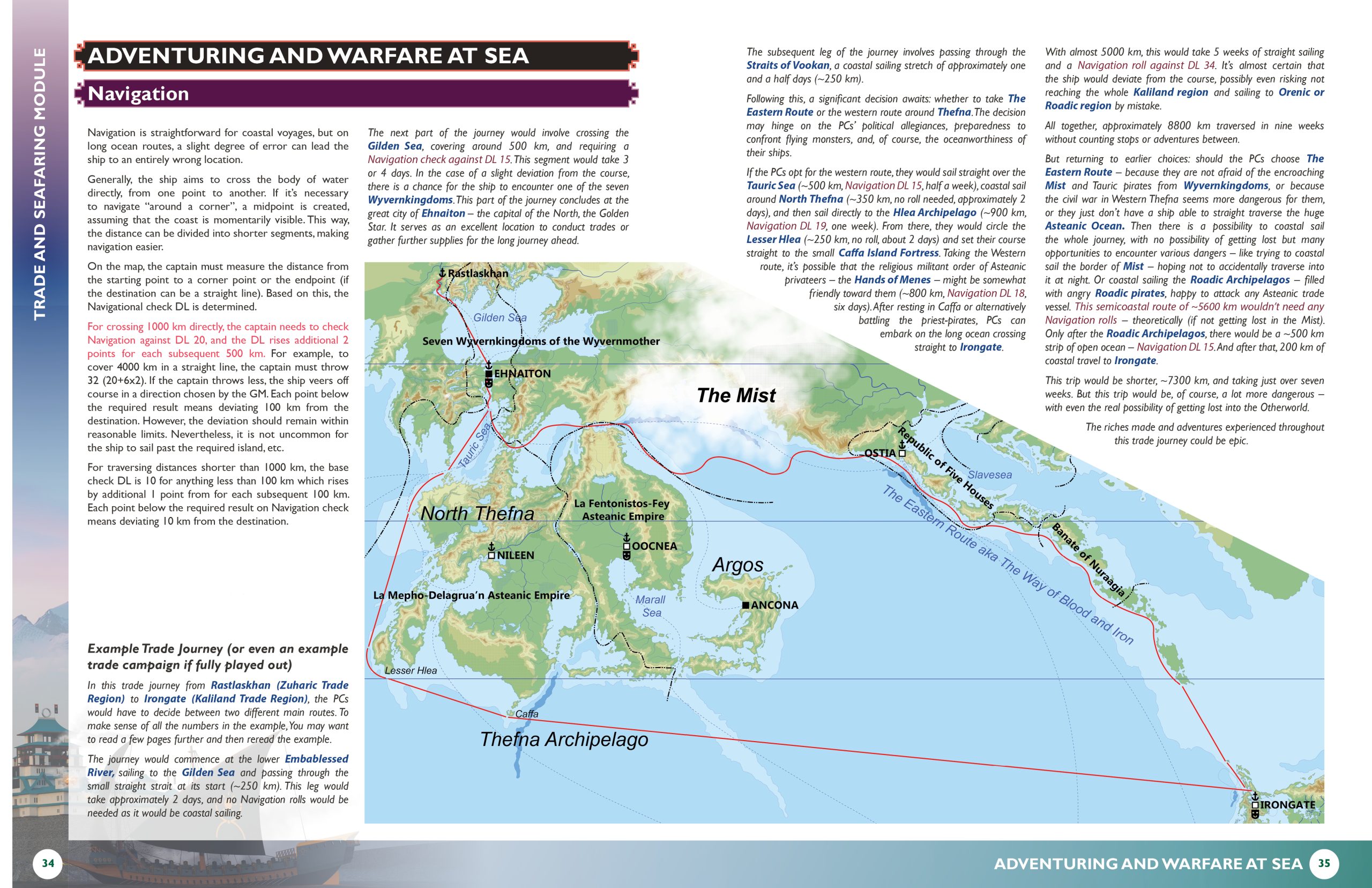
In this trade journey from Rastlaskhan (Zuharic Trade Region) to Irongate (Kaliland Trade Region), the PCs would have to decide between two different main routes. To make sense of all the numbers in the example, You may want to read a few pages further and then reread the example.
The journey would commence at the lower Embablessed River, sailing to the Gilden Sea and passing through the small straight strait at its start (~250 km). This leg would take approximately 2 days, and no Navigation rolls would be needed as it would be coastal sailing.
The next part of the journey would involve crossing the Gilden Sea, covering around 500 km, and requiring a Navigation check against DL 15. This segment would take 3 or 4 days. In the case of a slight deviation from the course, there is a chance for the ship to encounter one of the seven Wyvernkingdoms. This part of the journey concludes at the great city of Ehnaiton – the capital of the North, the Golden Star. It serves as an excellent location to conduct trades or gather further supplies for the long journey ahead.
The subsequent leg of the journey involves passing through the Straits of Vookan, a coastal sailing stretch of approximately one and a half days (~250 km).
Following this, a significant decision awaits: whether to take The Eastern Route or the western route around Thefna. The decision may hinge on the PCs’ political allegiances, preparedness to confront flying monsters, and, of course, the oceanworthiness of their ships.
If the PCs opt for the western route, they would sail straight over the Tauric Sea (~500 km, Navigation DL 15, half a week), coastal sail around North Thefna (~350 km, no roll needed, approximately 2 days), and then sail directly to the Hlea Archipelago (~900 km, Navigation DL 19, one week). From there, they would circle the Lesser Hlea (~250 km, no roll, about 2 days) and set their course straight to the small Caffa Island Fortress. Taking the Western route, it’s possible that the religious militant order of Asteanic privateers – the Hands of Menes – might be somewhat friendly toward them (~800 km, Navigation DL 18, six days). After resting in Caffa or alternatively battling the priest-pirates, PCs can embark on the long ocean crossing straight to Irongate.
With almost 5000 km, this would take 5 weeks of straight sailing and a Navigation roll against DL 34. It’s almost certain that the ship would deviate from the course, possibly even risking not reaching the whole Kaliland region and sailing to Orenic or Roadic region by mistake.
All together, approximately 8800 km traversed in nine weeks without counting stops or adventures between.
But returning to earlier choices: should the PCs choose The Eastern Route – because they are not afraid of the encroaching Mist and Tauric pirates from Wyvernkingdoms, or because the civil war in Western Thefna seems more dangerous for them, or they just don’t have a ship able to straight traverse the huge Asteanic Ocean. Then there is a possibility to coastal sail the whole journey, with no possibility of getting lost but many opportunities to encounter various dangers – like trying to coastal sail the border of Mist – hoping not to accidentally traverse into it at night. Or coastal sailing the Roadic Archipelagos – filled with angry Roadic pirates, happy to attack any Asteanic trade vessel. This semicoastal route of ~5600 km wouldn’t need any Navigation rolls – theoretically (if not getting lost in the Mist). Only after the Roadic Archipelagos, there would be a ~500 km strip of open ocean – Navigation DL 15. And after that, 200 km of coastal travel to Irongate.
This trip would be shorter, ~7300 km, and taking just over seven weeks. But this trip would be, of course, a lot more dangerous – with even the real possibility of getting lost into the Otherworld.
The riches made and adventures experienced throughout this trade journey could be epic.
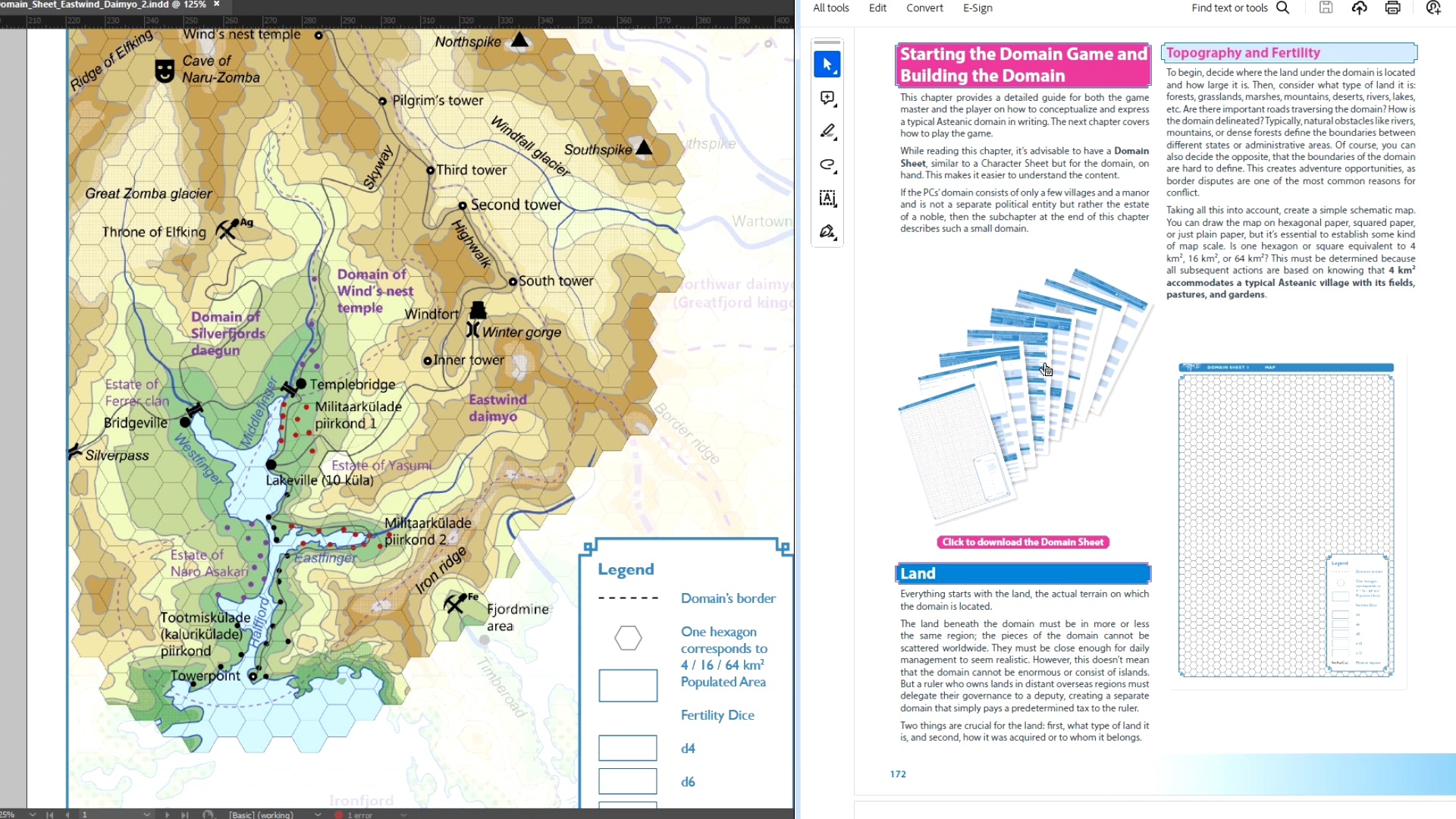
So, took some time, and made a video tutorial on using the domain-building rules. I have wanted to do it for a long time, and now it’s done. Enjoy! Thank You for watching!
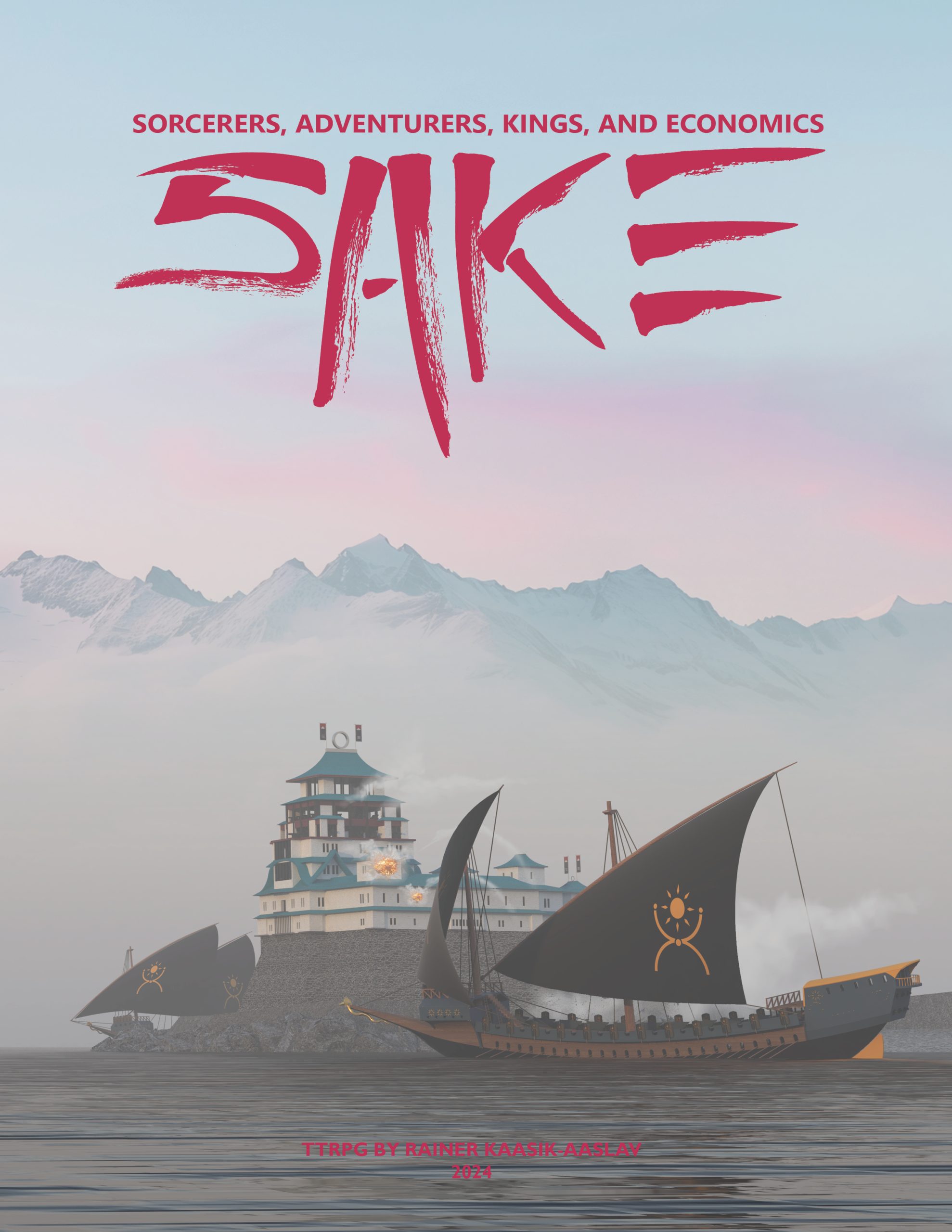
This post is primarily intended for other aspiring designers like myself, but it can be a (long) interesting read for others nevertheless, offering insights into the decisions and work behind the scenes of SAKE.
It has been a few days more than two months since I published SAKE (Sorcerers, Adventurers, Kings, and Economics) Basic Edition, and titled myself as a game designer (Link to First Field Report: https://sake.ee/field-report-after-the-first-week-of-publishing/ ). It’s going to be a long post, so let’s get right to it.
The Basic Edition has been downloaded exactly 708 times at the moment of writing. 30 people who downloaded it decided to pay for it, and I am immensely grateful for that. So, in total, it’s a 4.2% paying rate. However, it’s not that simple. There was a post in the TTRPG designers subreddit a few weeks ago discussing that on DriveThru RPG, more people decide to give money for PWYW (Pay What You Want) products. I see a similar trend here, as 24 out of 30 payments are from DriveThru RPG, but only 317 downloads are from there. So, that is something to keep in mind if you are planning to sell your products at the price of PWYW and hope to make some money out of it. As for me, the Basic Edition is meant to be a free preview, and I am very thankful for people who have decided to support my endeavour.
After finishing the book, I started simultaneously with three things:
I have sent out 23 review requests, and to be honest, I am very positively surprised. Before, I was afraid that I would be sending those emails into oblivion (or the spam folder) and nobody would answer. But that’s not the case. Even if nothing has come from it yet, many people still took their time to answer (around 1/3), and I am very thankful for that.
Also, in three cases, something more has happened:
So, all together, I am very happy with this, and writing it down reminds me that I probably should get some more emails out.
After releasing the Basic Edition, I straight away started working on an adventure module Crime Districts of Irongate, which I published in January. But mind you, I didn’t write a whole book in one month; I mostly edited and rewrote material that I had written throughout the year when taking part in the Dungeon23│City23 challenge. Most of the blog posts here are about the Irongate City.
I priced it at $5,99 and sold exactly… drumroll… two copies (Thank You so much for You two!).
That sounds like a total failure, but I don’t see it that way, mainly because of two reasons:
Anyway, if you want to take a look, here are the links:
DriveThru RPG: https://www.drivethrurpg.com/product/468117/Crime-Districts-of-Irongate?affiliate_id=4178266 (affiliate link)
Itch.io: https://rainer-kaasik-aaslav.itch.io/crime-districts-of-irongate
The Importance of Facebook Ads
There were an estimated 13,7 million active D&D players (WotC made that estimation in 2017). How many active TTRPG players that translates to in 2024 is hard to say, but it’s likely more. All types of groups on Reddit, FB, forums, etc., have a lot fewer participants, and the active participant count is even lower. (r/rpg has 1,5 million users – hard to estimate how many users per day or week).
So, the reason for FB ads basically comes down to reaching those people who play TTRPGs but don’t actively take part in online communities.
For personal economic reasons, I have only spent on ads as much as the book has earned.
I have tried several advertisement combinations, and the best one seems to be this sort of simple combination.
As you can see, it’s a long descriptive post, without an advertisement button (the click here thing), without any beautiful pictures or videos. Picture or video ads I have tried have worked more poorly than this type of simple posts, and for some reason, people tend to like it more when the main link is to DriveThru RPG.

After the Crime Districts of Irongate adventure was published, I have fully focused on preparing for the Full Release Kickstarter, which will open in the first half of April. And, as you can imagine, it’s a lot of work when you want to do it at as a professional level as you can.
With the final book, it’s been a lot of back and forth. As you can see from some materials on the Kickstarter prelaunch page and campaign video – there are two books, but right now I speak of one.
I started with the idea of one book of 450 pages Printed on Demand. 450 pages are a lot, but the Basic edition is almost 250 pages – the game just is large as it has all sorts of other systems for domain management, large battles/sieges, economy, and so forth. The PoD pre-calculations showed exorbitant prices for a hardcover full-colour book of this size. Just rechecked – over 90 dollars on Lulu. Adding my expenses, Kickstarter expenses, taxes, and we’ll be looking at a book with a selling price of almost 150 dollars – which is just crazy, and even crazier when taking into account the questionable print and paper quality of Print on Demand.
So, I decided to go with offset printing as it’s a lot (and I mean a LOT!) cheaper, better quality, and somewhat easier for me as I can communicate with printers quicker. Or so has been my experiences (I have published and printed 2 books in my time). For the time being, I decided not to bother with that more and started working with the Kickstarter video, also, not thinking much – decided that maybe printing two books would be better – that’s why you see two books in the Kickstarter video right now.
But. Think about it! The price of offset printing is cheap because you print a lot of books – print run under 300 would get very expensive again and basically costs the same as 300 books. So, two books would really mean 300 + 300 books for me, and that would be too risky for two reasons:
So, that’s why back to one book, with that, the base goal can be around 10 000 dollars, which shouldn’t be too frightening for such a large book.
There is one thing extremely useful for me in this endeavour – my artist background. I am a metal artist, and while not as at home with illustrating or graphic design, I still can do them at some levels.
Also, another thing I have recently decided to do more – is play on my stronger suits – which is 3D – an important thing when visualizing large sculptures and engineering their structures – but same useful for modelling ships and castles. And those models can be used in wildly different settings. For example, you can see this one ship in:


Same with the castle, that will be added to the video also.



So, as you can see – I try to work as efficiently as I can, using the same things in different scenarios, as for Kickstarter you need a lot of small bits and pieces: Mockups, icons for pledges, page spreads, and so on – and a lot of this stuff is useless for the final product, so I really try to make it in the way I can use it still in the final product and don’t waste my time on useless graphical bits and pieces.
I could write so much more, but I think the most important things have been mentioned for now, and the post is getting huge (4 pages in Word). So, best wishes and Thank You for reading!
Rainer Kaasik-Aaslav

As I type this, the SAKE Basic Edition has been published in Itch.io and DriveThru RPG for exactly one week. This field report is aimed more at myself and other novice game designers. I aim to describe the behind-the-scenes aspects as accurately as possible, but there might be some limitations – for instance, I am unsure if I can take screenshots from the Publisher section of DriveThru RPG or Itch.io without violating any rules, so I refrain from doing so just in case.
Everything preceding this: designing the game, testing it, and designing a beautiful book, is generally straightforward. However, the real work begins after this process is complete, and as a novice game designer, it feels like uncharted territory. Although I have designed and/or compiled two books in my lifetime, I have never had to sell them myself, and they have mostly been local publications.
The first thing to note is that the feeling is good. Now, it’s done. Before publishing, I had this sort of ambivalent feeling, thinking of myself as a TTRPG designer. Yes, I have been designing this for years – it should mean I am one, but nobody else than my groups had played or even seen it – so, am I really? Would anybody else believe that I am? Like, if you study jewellery and never finish or sell a piece of jewellery, then are you a jewellery artist? So, I am happy I pushed it out, even if I would have liked to have an accompanying adventure, which it doesn’t have yet.
In the first week, SAKE has been downloaded 298 times: 95 times from DriveThru RPG and 203 times from Itch.io.
On Itch.io, there are 1062 views on the page, so that’s 19.1% of page views.
On DriveThru RPG, those 95 downloads came from 484 views, so that’s 19.6%. Surprisingly similar. I am not sure if I can know how people found their way there.
Most of those downloads on Itch.io (135) happened in the first two days, and Itch.io shows me that most people came to the page from Reddit, followed by Itch.io’s own new and popular category, and after that is Facebook. Which is understandable because…
I have always been able to share pictures and links to the webpage with the SAKE Facebook page, but this time it was impossible, like Facebook understood that those links are shop links and no-no, those things we don’t share freely – you have to buy advertisement or not share at all. Comparison: some random map picture – 2800 views (just checked, some even have 10K views), an important post about SAKE being published – 485 views. And the first several days it was under a hundred. Okay, no problem, I understand this; that is their business model, just was not prepared to discover it this way.
Anyway, 300 downloads sound great (maybe, I am not sure, first time doing it), but it comes with a big ‘but’ – the game is PWYW (Pay What You Want), so the number of readers may be a lot lower. But that’s something that I can’t evaluate yet.
I have been told that I should ask money for the game as nothing else than this book is needed to play it, but I still decided to go with PWYP because at this moment I feel that getting the game to as many people as possible is more important than trying to earn a few hundred bucks. I am unknown and building some audience is crucial.
Anyway, if things go the way I want, then this is just a start. On my computer, there are hundreds, if not thousands, of pages on the Asteanic World, monsters, adventures, etc., waiting to be translated, edited, and converted into books. So having the first one free is not the end of the world in an economic perspective.
Having the Basic Edition published comes with a great benefit in those shops; everybody who downloads SAKE – I can send an email. I will not abuse it, sending some random news, but I will send an email when I publish something new or the Kickstarter opens.
Speaking of Kickstarter, I haven’t advertised it much yet, but the link is in the PDFs and on the Itch.io page (it’s not allowed to put this sort of links into DriveThru RPG page), which has brought in 34 pre-subscribers. Again, I don’t know if those numbers are good or not – I have read that around 20% of pre-subscribers convert to backers. Is it true? Maybe? Anyway, I wouldn’t dare to open Kickstarter before there are around 500 people interested – it’s just a limit I have set for myself. Maybe after I find some more info, I may reconsider it one way or the other.
Apart from Reddit, Facebook (where I invested 10 euros in an advertisement to test the system), Instagram, Mastodon, Twitter (where I proudly have just one follower!), and now Threads, I have posted the game ad on various TTRPG forums across the internet. However, the download numbers have slowed down – yesterday, Monday (18.12.2023), saw 6 downloads on Itch.io and only 1 on DriveThru RPG. So, it’s time to move to the next stage. Simply posting shop links doesn’t work anymore – which is logical, as nobody likes relentless advertisements.
I plan to reach out to a few reviewers and hope to see some reviews after some time. Right now, there are none, which is okay. I am unknown figure in the TTRPG world, and the game is a lengthy read (246 pages + all sheets), making it challenging to review right away.
What I didn’t have at the time of release is a sample adventure. That is the next thing I plan to change. This will also allow me to test a few other things, like what happens when I put a price tag on it. Do 300 downloads become 3, or even 0? I would call it a great success if there were 50 downloads with a price in the first week. Let’s see.
So, the plan is to use the material that I have been creating for the #dungeon23 project and convert part of it into a city district-themed dungeon, which is going pretty well.
I drew a basic plan a few days ago:

After gathering all existing materials, I am now reviewing them, adding some Hazards, Opportunities, and Secrets.
The same file this morning:

And the Crime Districts Dungeon Sheets as they are now:
But the main work hours will go into the design of battlemaps because, while mostly done in Rhinoceros (CAD program that I use to draw), they still haven’t been converted into Illustrator.
Right now, I have these:
I still don’t understand how to use all those Meta tools; the business part of the page is extremely confusing to me. It’s pretty hard to even say what exactly I don’t understand 😀 So, that’s the thing I have to study more. I plan to use Meta advertising, just have a 10 euro a week advertisement running basically all the time. But to make this effective, I just have to understand better what I am doing – and find a way to see the results better. Last week’s 10 euro advertisement brought 46 clicks into Itch.io, which altogether has 1062 clicks. But I have no idea how many of those 46 clicks became downloads. There probably is a way to know it.
And I have to do something with the webpage, which hasn’t aged well in one year 😀
Another thing I am thinking of is making the Basic Edition into Print on Demand in DriveThru RPG. It shouldn’t be too complicated – famous last words. Really, probably just add bleed, make a separate file for covers and … ??? The downloadable parts of the file are, anyway, a separate layer in the InDesign file; those will be gone with just one click. But even simple things take time, and that’s why it’s down here in the list of things to do.
So, that’s the report and thoughts for now. I am happy for all sorts of advice! The next report will probably be after the release of the dungeon and seeing how that goes, so probably a month or something.